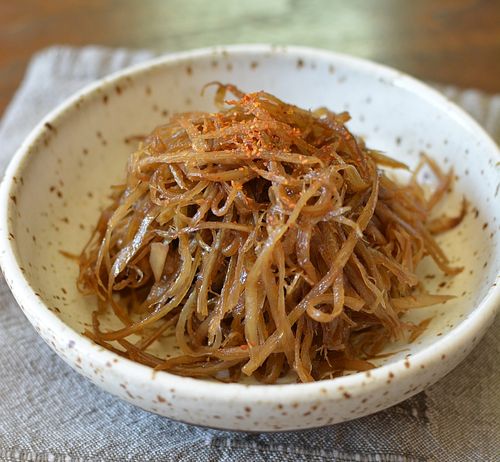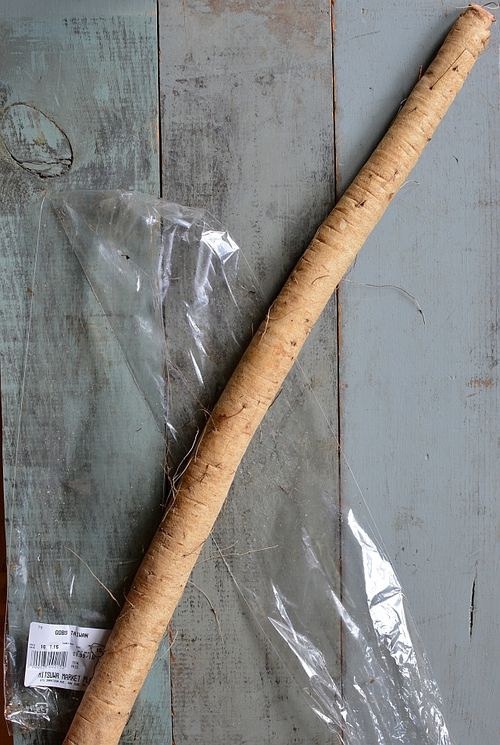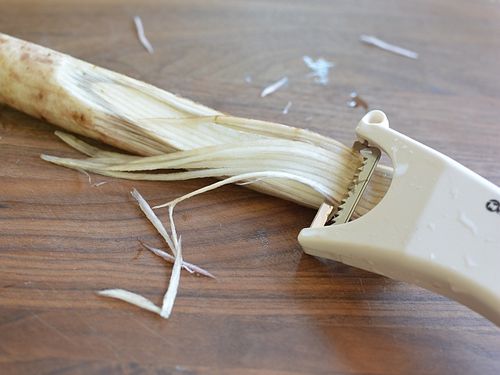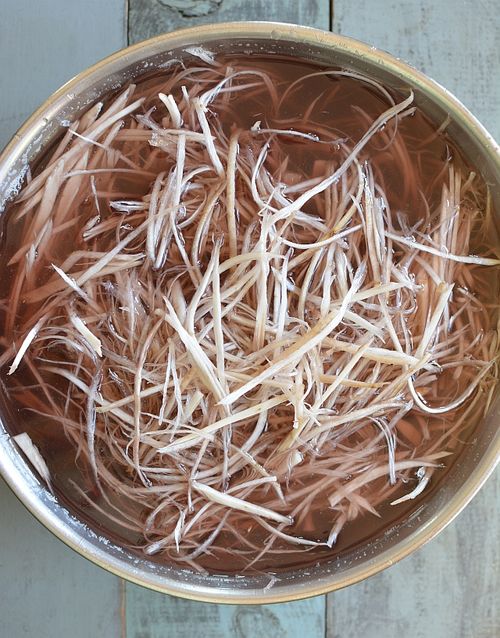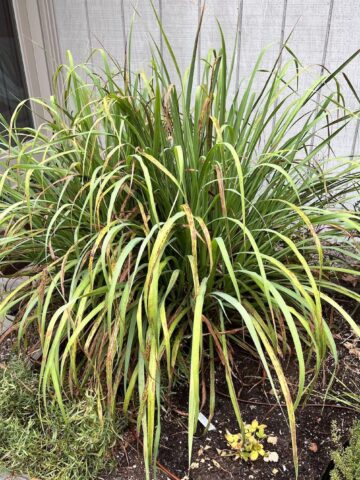My husband recently told me that he wanted to eat gobo (burdock) root. Would I make some? It’s suppose to be great for an alkaline-acid diet, which balances your body. Rory has been getting into that lately. I love root vegetables and have been wanting a good excuse to try the gobo sold at Asian markets. The roots are long, large, and if you’re not familiar with them, oddly woody. They are mostly associated with Japanese cooking, though the ones at Mitsuwa market are from Taiwan. They are a lot bigger and lighter in color than ones I’ve seen sold at my farmers’ market. The bigger ones are easier to deal with.
Burdock tastes like and earthy and dry version of parsnip. The slender root is known for many health benefits, ranging from fighting bacteria and cancer to battling inflammation and high blood pressure. No wonder I had to buy a one-pound root, which was roughly 30-inches (75 cm) long. Labeled as gobo, it cost a whole $2 at Mitsuwa market. Rory was giddy when I brought it home in its long plastic sleeve.
A favorite way to prepare burdock is as kinpira, a simple Japanese vegetarian dish that’s savory-sweet, a little rich, and tinged with chile heat. Kinpira refers to the cooking process or sauteing and simmering vegetables in seasonings to create deep, lasting flavor. According to Shizuo Tsuji in The Simple Art of Japanese Cooking, ,inpira is also “a strong and dashing mythical hero of old Japan.”
The hardest thing about preparing burdock is cutting it. The root is very firm. Tsuji’s recipe called for prepping the burdock into shaving, like as if you were sharpening a pencil. I have a Japanese kinpira tool similar to this one. It’s basically an Asian version of a julienne peeler. I bet you could put it through the food processor, with a medium shredder attachment. You want thin, dramatic pieces (strong and dashing!) so keep the root longish.
Burdock discolors in a most beautiful manner too. A few minutes after being cut, the pieces darken. Soak them in water and they turn the water a lovely color and return to their lighter shade.
I used dark Japanese shoyu and light Chinese soy sauce to test the recipe and found that both work well. Tamari or a gluten-free soy sauce would be fine. For the heat, Japanese ichimi togarashi ground pepper is my go to, though the shichimi togarashi 7-spice blend is fabulous too. I keep a large bottle of sake to cook with but you can use any dry sake.
The great thing about kinpira is you can make a lot from one root and keep it around for days to enjoy with rice and other dishes, or as a stand-alone nibble. It’s terrific on its own and plays well with others.
If you don’t have burdock (gobo), try substituting 1 ¼ pounds of parsnips and carrot (use a 1:1 ratio) and cut the vegetables into the size of slender bean sprouts.
Gobo buying tips: Look for roots with even texture and color. I prefer ones with relatively few straggly roots. Once home, refrigerate it for up to several days. At Japanese, Korean and Chinese markets, it likely near other root vegetables.
RECIPE
Burdock Kinpira
Kinpira Gobo
Ingredients
- 1 pound burdock root
- ¼ cup (60 ml) dry sake
- ¼ cup (60 ml) soy sauce (choose regular Chinese, dark Japanese, or gluten-free)
- Scant 2 tablespoon sugar
- Canola or other neutral oil, for sauteing
- ½ teaspoon Japanese ground chile pepper or 7-spice blend (ichimi or shichimi togarashi), plus more for garnish
Instructions
- Scrub the burdock root with a vegetable brush. Use a julienne or kinpira peeler to cut the burdock into shavings. Aim for a thin long julienne. Hand cut any lingering thin pieces to avoid cutting yourself with the peeler. As you work, put the burdock into a bowl of water.
- Stir together the sake, soy sauce, and sugar. You will be cooking the burdock in 2 batches so divide the mixture, if you like. Drain the burdock.
- Pour oil to film the bottom of a large skillet. Heat over high heat, then add half of the burdock. Cook, stirring, until softened, 2 to 3 minutes. Stir the sake, soy, and sugar then add half of it to the skillet. Cook, stirring, until the liquid has mostly disappeared. Season with half of the ground chile or spice blend. Transfer to a bowl or plate to cool. Repeat with the other batch.
- When done, you can eat the kinpira or refrigerate it. Enjoy hot, warm, or at room temperature. Present it in a communal bowl or individual dishes. It pairs well with sake.
Do you have a favorite way of preparing burdock (gobo)?













